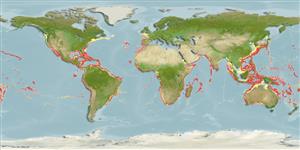Classification / Names
Common names from other countries
Main reference
Size / Weight / Age
Max length : 100.0 cm SL male/unsexed; (Ref. 6181); common length : 40.0 cm SL male/unsexed; (Ref. 3403)
Length at first maturity
Lm 47.4 range ? - ? cm
Environment
Marine; benthopelagic; oceanodromous (Ref. 51243); depth range 80 - 800 m (Ref. 2683), usually 300 - 400 m (Ref. 5217)
Climate / Range
Subtropical, preferred 26°C (Ref. 107945); 50°N - 36°S, 180°W - 180°E
Distribution
Short description
Dorsal
spines
(total): 18 - 20;
Dorsal
soft rays
(total): 17-20;
Anal
spines: 2-3;
Anal
soft rays: 15 - 17. Body moderately elongate. Mouth with fang-like teeth. Spinescent gill rakers on the first arch with 1 - 3 cusps and many small spines; the angular raker long and triple-rooted. Body entirely scaled at over 20 - 25 cm SL. Pyloric caeca 7 or 8. Color is grayish to copper brown; fins blackish at over 40 cm SL, yellowish with black tips in smaller specimens (the first dorsal fin with a black blotch on two anteriormost membranes); the buccal and branchial cavities are black. Pelvic fin reduced to one spine that becomes entirely absent in specimens more than 40 cm SL.
IUCN Red List Status (Ref. 115185)
Threat to humans
Reports of ciguatera poisoning (Ref. 31637)
Human uses
Fisheries: subsistence fisheries; gamefish: yes; bait: usually
Tools
Special reports
Download XML
Internet sources
Estimates of some properties based on models
Phylogenetic diversity index
PD50 = 1.0000 many relatives (e.g. carps) 0.5 - 2.0 few relatives (e.g. lungfishes)
Trophic Level
4.2 ±0.57 se; Based on food items.
Resilience
Medium, minimum population doubling time 1.4 - 4.4 years (K=0.17-0.18; tm=4)
Vulnerability
High vulnerability (57 of 100)
Price category
